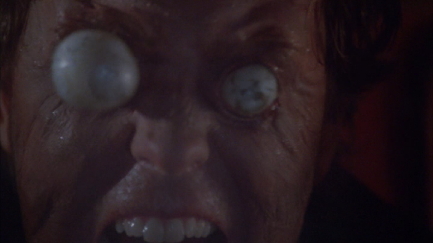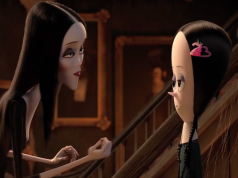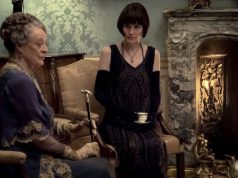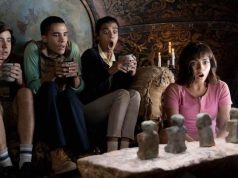(Written in 2007 for the “Retro Cinema” feature at Cinematical.)
If you were to ask the 9-year-old version of me what the scariest movie ever made was, he would say it was “Twilight Zone: The Movie” — a film so terrifying that I was reduced to tears merely by my father’s description of it.
Specifically, he was telling us about the opening sequence, the one that begins with Albert Brooks and Dan Aykroyd listening to “Midnight Special” on a cassette tape and ends with Aykroyd saying, “You wanna see something really scary?” and then making good on his pledge. For some reason, the way my dad retold this story — which really is a good campfire-type story, when you think about it — scared the living daylights out of me. I immediately freaked out, sobbing and screaming. The mere idea of the story tormented me, to the extent that I couldn’t actually watch the movie for years to come.
(If the preceding anecdote gives you the impression that I was a total pansy as a child, that impression is accurate.)
I did finally watch the film a couple times as a teenager and young adult, and again recently when it was released on DVD for the first time. That prologue with Aykroyd and Brooks? Still pretty great. You don’t know it’s going to have a scary ending because most of it is just the two men talking about old TV shows and their favorite “Twilight Zone” episodes. That “You wanna see something really scary?” bit comes as a shock, an abrupt change in tone that exemplifies “The Twilight Zone’s” single best attribute: the ability to surprise us.
Released in 1983, “Twilight Zone: The Movie” boasted an impressive pedigree, coming from four directors whose work was already highly regarded (at least in some circles). John Landis had scored with “Animal House” and “The Blues Brothers,” Joe Dante’s “The Howling” was a cult hit, George Miller’s Mad Max films were gaining traction, and Steven Spielberg — well, he was Steven Spielberg, for crying out loud.
Landis wrote and directed the prologue and the first segment. They’re the only parts not based on a “Twilight Zone” TV episode, but they certainly fit the spirit of the show. In Segment 1, a one-dimensional bigot named Bill (Vic Morrow) loudly proclaims his hatred of Jews, blacks, and Asians, only to subsequently find himself mistaken for each of those persuasions by, respectively, Nazis, the Klan, and American soldiers fighting in Vietnam. In typical TZ style, no explanation is given for the nightmare scenario, and there’s no rhyme or reason to his sudden jumps in time and location. You get the feeling there are only two options: Either he learns his lesson and gets his real life back, or he is killed by one of the racist groups pursuing him.
Originally, Bill was meant to find some redemption. As everyone knows, however, Vic Morrow was killed by a helicopter while filming one of the Vietnam scenes, along with two young children hired as extras. (The character was rescuing the Asian kids from danger, something an unrepentant Bill wouldn’t have done.) Enough of Segment 1 had already been shot for the story to work, but now it has a non-redemptive ending — which I like, because it makes the story more haunting.
It also has a shadow cast across it, knowing what happened to Morrow and the kids, and knowing that Landis and company went ahead and released the film anyway, which you could argue was in poor taste. (Definitely tasteless in my opinion: not including a dedication to the three victims’ memory in the closing credits.) Second assistant director Anderson G. House, who had spoken out against the helicopter stunt to begin with, had his name replaced with “Alan Smithee” in the credits. You’ll find a lengthy but fascinating discussion of the whole incident at TruTV’s Crime Library.
Segment 2 is Spielberg’s, undeniably the worst of the lot, and utterly misguided from the start. It’s a wistful little story about a retirement home where the old people wish to be children again, are granted their wish through a magical game of kick the can, and subsequently realize they don’t want to deal with getting old all over again. The logic behind including this segment is sound, as this story was used in a TZ TV episode, and plenty of other episodes were just as whimsical. Heck, some were out-and-out comedies. The problem is, that’s not what people remember. “The Twilight Zone” is best known for its melancholy tales of horror and supernatural irony. Even if one-fourth of the episodes were lighthearted, it still doesn’t feel right to make one-fourth of the movie that way.
And that’s apart from the segment’s other inherent weaknesses. I’d always remembered this one as being a letdown simply for its lack of spookiness; watching it again, I see it’s also a letdown for being oversimplified and rushed. The old people are turned young in an instant — and almost immediately, they wish to be old again. This is a story that could have benefited from being extended a little further, its ideas fleshed out. As it stands, it’s perfunctory and simplistic, though there’s no denying Spielberg’s knack for appealing shot compositions and general proficiency. I’d rather watch Spielberg’s worst short film than Uwe Boll’s best feature.
I did discover a way to make the story more fun, though: Pretend that Scatman Crothers’ character, the one whose mysterious powers make the adults young again, is the devil. Actually, pretending that a random character is the devil probably makes most movies more fun.
Segment 3, from Joe Dante, is based on the classic TZ episode “It’s a Good Life,” in which a boy has unlimited mental powers, able to wish for and instantly receive anything he wants. The boy who played that role originally, Billy Mumy, appears in the segment as a diner patron. He was also half of the duo behind the classic novelty song “Fish Heads.” Now you know!
Directed by Joe Dante, this segment is unquestionably my favorite. In my younger days, I admired its out-and-out freakiness, not to mention the enviable powers possessed by young Anthony (Jeremy Licht, later of TV’s “The Hogan Family”). Seeing it again now, I note a couple of things. One, the production design is fantastic, Anthony’s house bearing an unsettling resemblance to the cartoon world he loves; and two, this segment is still pretty creepy. Everything about it, from the “family” members’ skittish behavior to the outright terror that comes later, is pure, unfiltered nightmare fuel.
And the girl with no mouth! Remember the girl with no mouth?! Holy crap, that’s freaky. That and “Do you wanna see something really scary?” are my most enduring memories of this film.
The last segment, from George Miller, is based on another famous TZ episode, “Nightmare at 20,000 Feet.” It’s extra-famous now for having starred William Shatner in his pre-Kirk days; in the movie, it’s John Lithgow as Mr. Valentine, a nervous airline passenger who thinks he sees a monster out on the wing, tearing the plane apart during a storm.
This story is the fun kind of scary (as opposed to the haunting kind), a gleeful roller-coaster ride bolstered by what I’d have to say is the film’s one truly great performance. Lithgow, sweaty and panicked for the entire segment, is fully committed to Mr. Valentine’s terror, and it’s a lot of fun to watch.

Miller pulls a neat trick about halfway through, when Lithgow opens the window shade and comes face-to-face with the monster. We see the creature’s leering, slimy face up close for about two seconds, then cut quickly to a zooming reaction shot of Lithgow. Except it’s not just Lithgow: He’s got prosthetic eyes that bug out cartoonishly. The shot only lasts five frames, and the goggle eyes are only obvious in the last two. It passes so quickly you’re liable to think it was just a terrified reaction shot and that the huge eyes you thought you saw were merely a trick of the mind. But it has exactly the effect Miller must have intended: to subtly add to the atmosphere of terror.
What’s a little disappointing about “Twilight Zone: The Movie” is that three of the segments have happy endings, and Segment 1 would have, too, if they hadn’t had to shoot around Morrow’s death. Wouldn’t it have been great to see a cruelly ironic end to the airplane story? Or for the old people to be stuck in their new young bodies, cursing the devilish Scatman Crothers for making them that way?
Oh well. We can always imagine what happens to Lithgow in that Aykroyd-driven ambulance at the end.
B (1 hr., 41 min.; )





